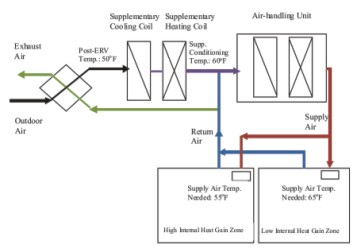
Why Condition Outdoor Air
While sitting in a waiting room reading the latest issue of Us Weekly in mid-January, the door opens and an icy arctic blast enters the room. Clearly, this is uncomfortable. This scene demonstrates why outdoor (ventilation) air is conditioned before being dumped into buildings. So, why not go the extra step and condition the air before the air handling unit using supplemental coils in addition to an energy recovery ventilator (ERV), as shown in the figure below? This could reduce maintenance and spread the loads between two sets of coils. What’s not to like?
The Monster
Adding heating and/or cooling coils in the outdoor air supply to a building often does more harm than good. It costs more to install and it costs more to operate. Tempering ventilation air with a building exhaust air heat exchanger is usually all that is required in most buildings, even if that means supplying 50°F ventilation air to the mixed air stream for air handlers and heat pumps on cold days. They are often 60-70% effective, meaning they can transfer up to 70% of the energy leaving the building to the incoming air. Supplemental coils are too often used to bring ventilation air to 60-70°F resulting in the dreaded energy-devouring monster known as “simultaneous heating and cooling.”
How Supplemental Heating and Cooling Feeds the Monster
How does this happen? First, let’s talk about load diversity, which means that different zones (areas of the building) have different heating and cooling needs. In most buildings, only 1/3 of the heating and cooling loads come from ventilation. The other 2/3 comes from internal gains (equipment, people, lighting, etc.), heat conduction, infiltration, and others. By code, all occupied spaces must have ventilation, but not all spaces have the same loads.
A space with high net internal heat gain may need 55°F supply air, but the supplemental coil has already conditioned the outdoor air to 65°F. Energy is used to add heat after the ERV and then energy is used to extract it downstream. This is the monster at work. Take a look at the figure to see what this looks like. In the summer, the opposite problem can occur, where air is cooled too much if it is supplying a space with low internal heat gain. Don’t feed the monster! As a bonus, by not installing supplemental coils, the first cost of a project is reduced.
Potential Exceptions
ERVs do not need supplemental heating and cooling unless the facility requires very large quantities of outdoor air (laboratories, for example), precise humidity control, or, in some cases, heat pump systems.




